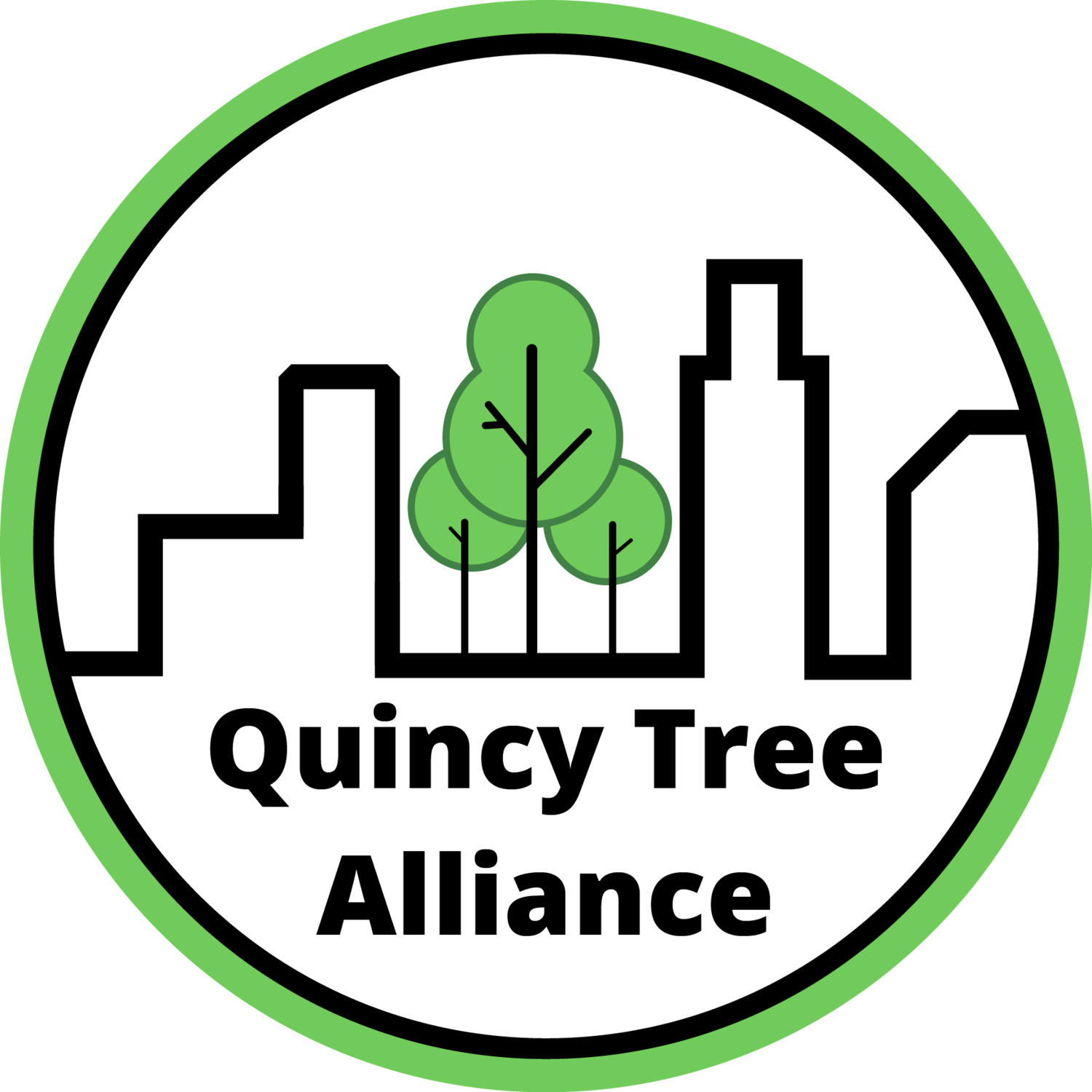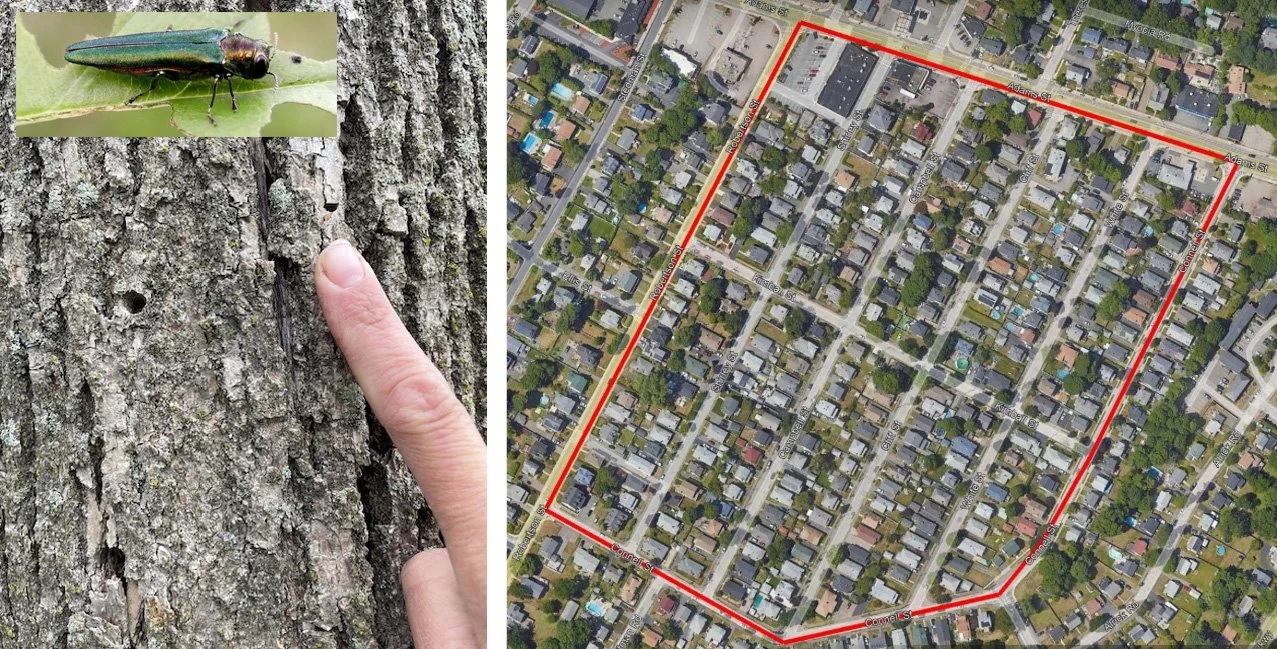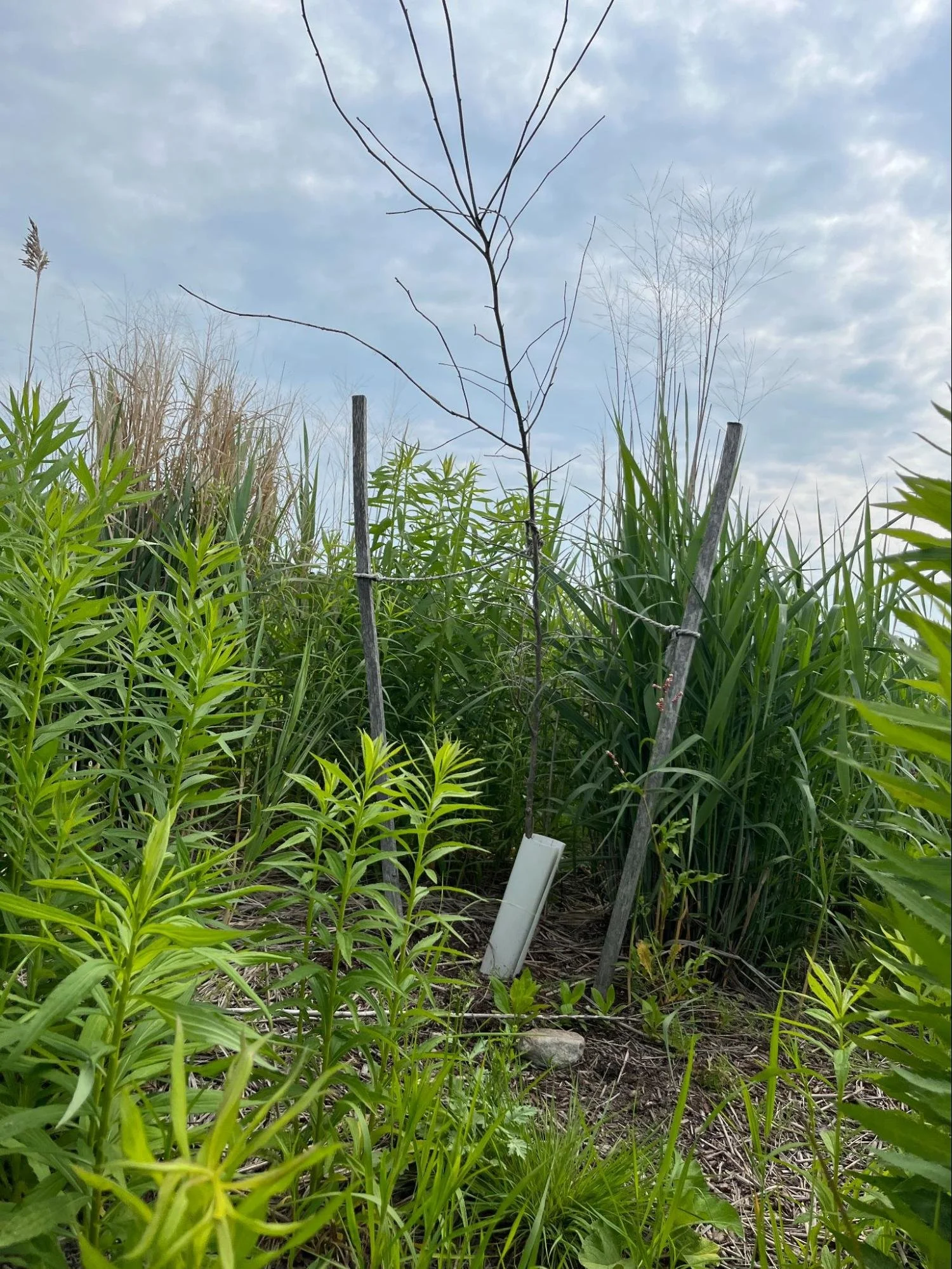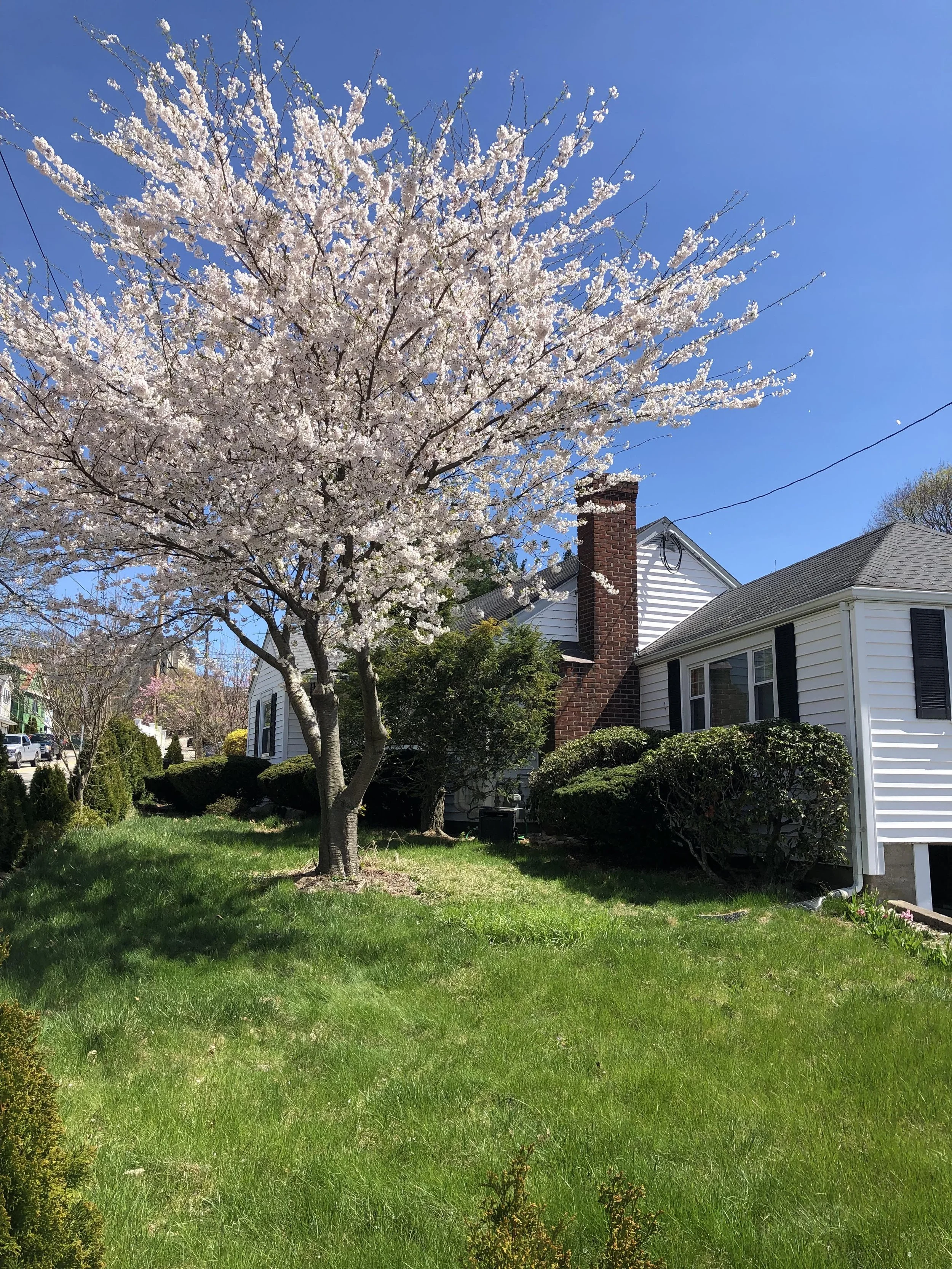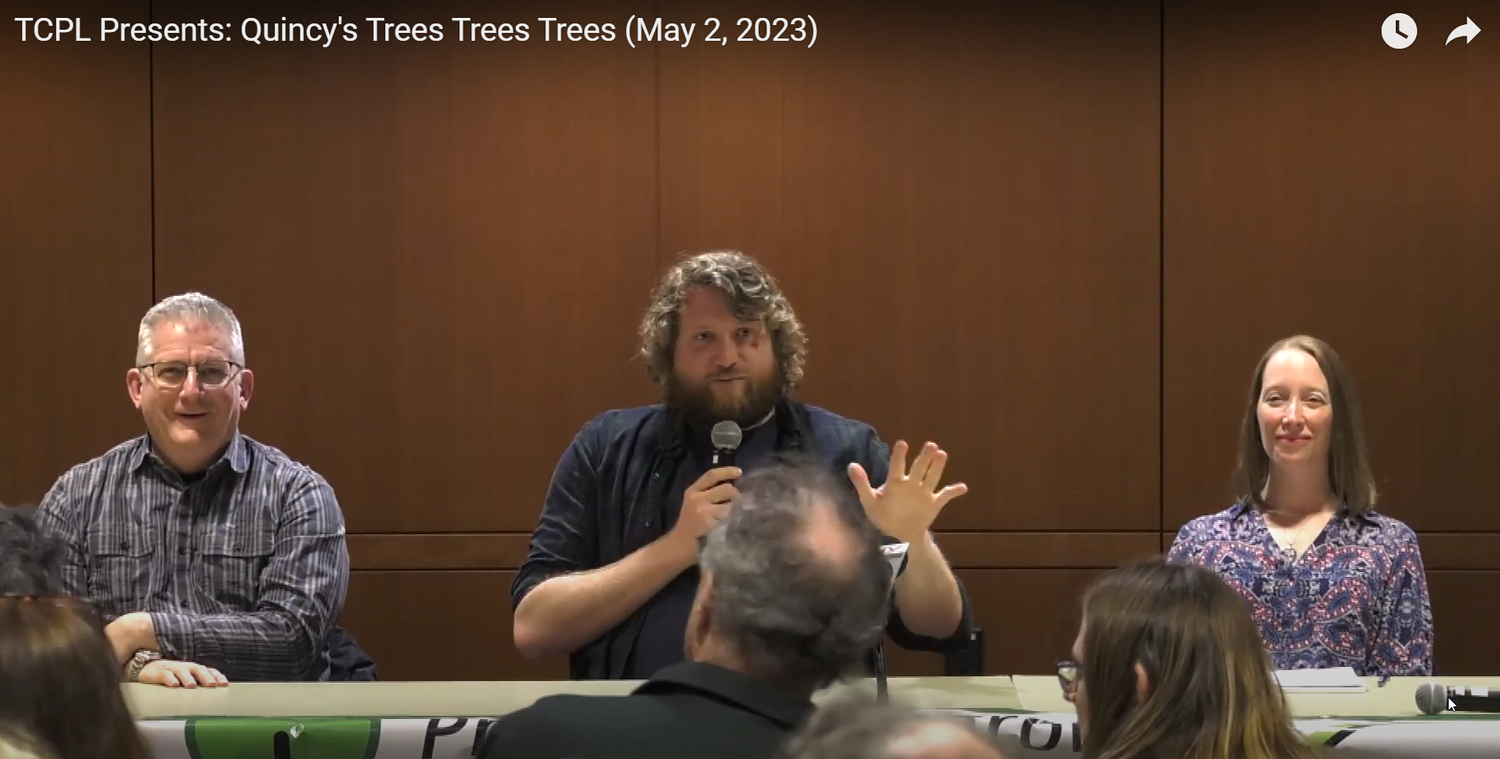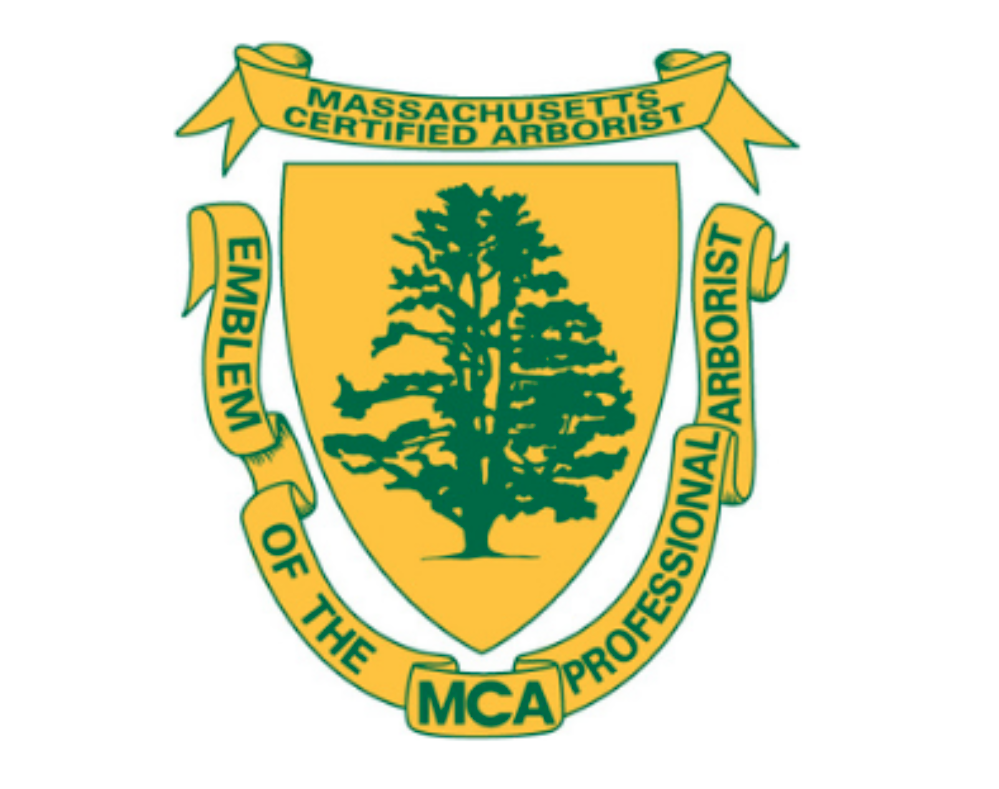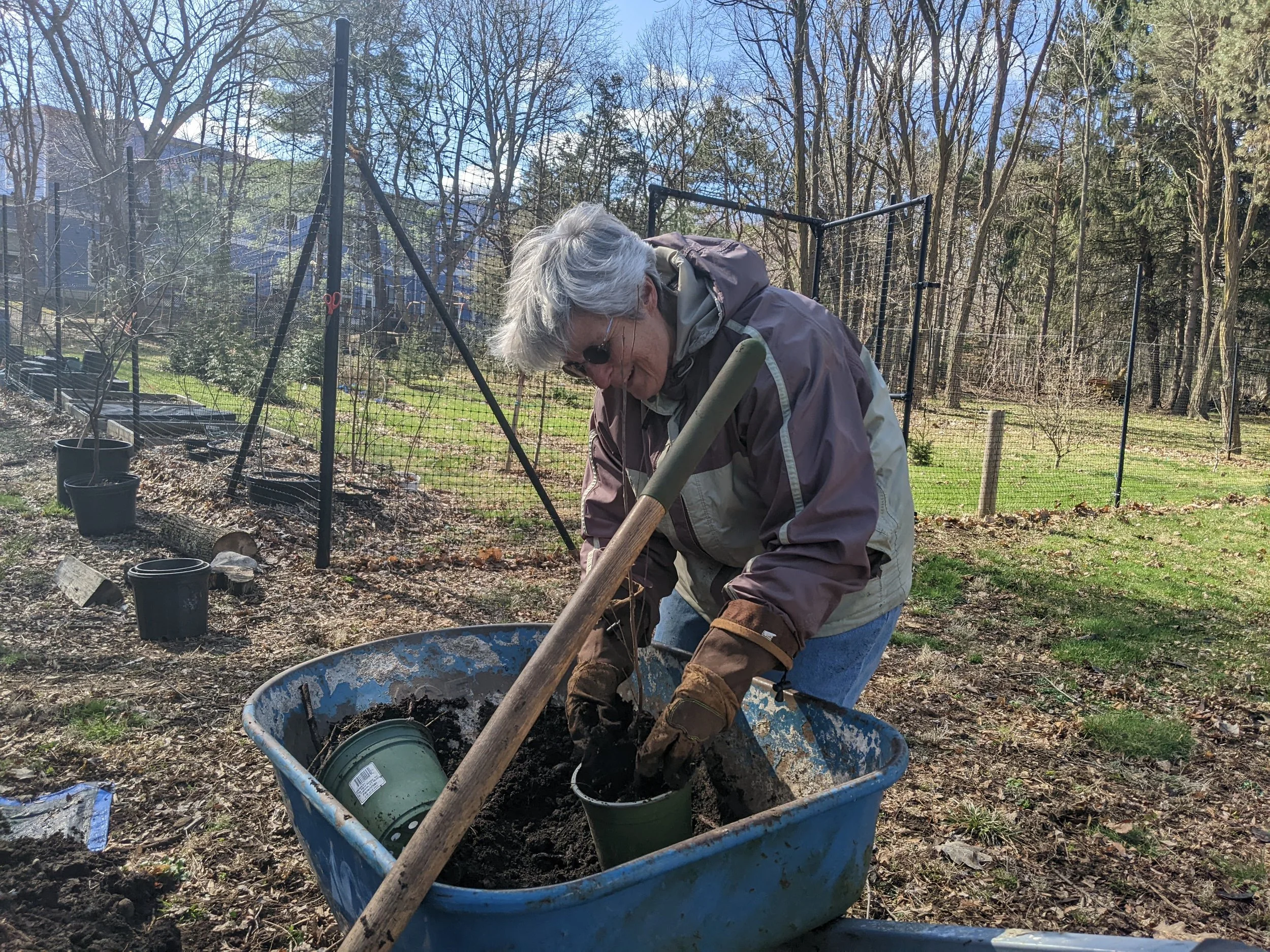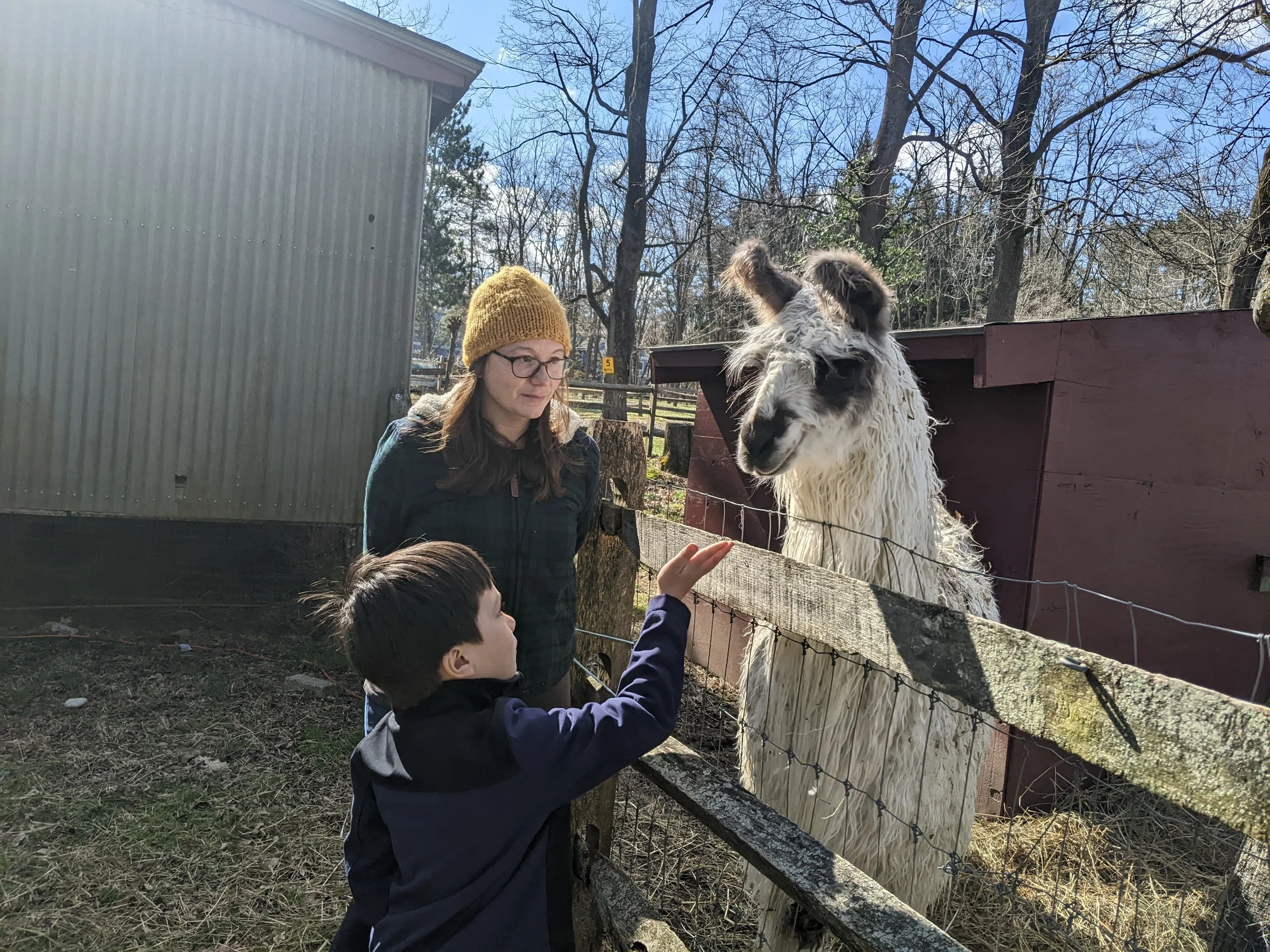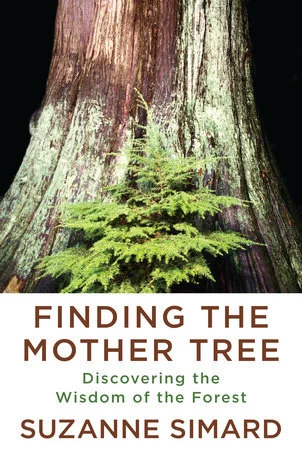Video: Tiny forests in Quincy
Tree warden Dan Cathcart and resident Maria Andrews discuss the tiny ‘Miyawaki’ forests they have planted or will plant in the city
Tree warden Dan Cathcart and resident Maria Andrews gave fun and fascinating presentations on mini Miyawaki forests at the main library in June. Watch their talks below.
June 25 library talk: Tiny Forests’ Big Benefits
Mini, fast-growing ‘Miyawaki’ forests are being planted in Quincy by residents and the city alike
When Maria Andrews moved back to her childhood home in Quincy Point, her backyard was barren – “all grass and one rhododendron,” she jokes. But two years ago, she planted more than 150 bare-root trees, shrubs, and ground cover plants on her property in an effort to create a tiny, crowded oasis known as a Miyawaki forest.
“It’s completely different now. Most trees have doubled in size, and the birch have outdone themselves – I have a birch almost to my second story,” she says. “And the wildlife I see is amazing. I saw hummingbirds last year for the first time.”
Mini forests offer a huge “ecological bang for your buck,” agrees city tree warden Dan Cathcart, who is planning to install one near the Quincy Adams T station this fall. The competition for sunlight makes the densely planted trees grow three to four times as fast as trees planted on their own. “You get all the same ecological services, from heat relief to contaminant filtration, but it comes faster,” says Cathcart. “The collective benefit of the individual trees is far less than the benefit of a forest.”
Andrews and Cathcart will discuss Miyawaki forests at the main library (40 Washington Street) on Tuesday, June 25, at 7 pm. The free talk is co-hosted by the Thomas Crane Public Library and the Quincy Tree Alliance, a volunteer organization dedicated to protecting and expanding the city’s tree canopy. For more information, visit thomascranelibrary.org/events-calendar and quincytreealliance.com.
This Miyawaki forest was planted in Cambridge’s Danehy Park
Maria Andrews is a lifelong resident of Quincy. She volunteers at Quincy Animal Shelter and is a member of Quincy's Invasive Species Management Committee. Maria is an animal advocate and nature lover who spends most of her time hiking in the woods with her dog, Sophia.
Dan Cathcart is the city’s tree warden. He won a federal grant for $750,000 to plant trees in environmental justice areas in Quincy and hopes to use about $300,000 of that to plant the City’s first mini “Miyawaki” forest near Quincy Adams T station.
Emerald Ash Borer Pest Alert
The emerald-colored beetle, a D-shaped exit hole and bark splitting, a neighborhood in Quincy of Adams Street where affected ash trees have been removed.
The Emerald Ash Borer (EAB) is an invasives beetle species that poses a significant threat to ash trees (Fraxinus spp.) in North America. The beetle has been identified in Quincy and the City has been removing ash trees that have succumbed to their damaging impact. The City will be replanting in these areas with careful consideration to site layout and species selection. Read more about EAB and the trees that have been removed from the Pest Alert the Department of Natural Resources put together here. Also see the Emerald Ash Borer Network website for more information. Please be on the lookout for trees that have the signs of the borer and report them to our tree warden, Dan Cathcart, at dcathcart@quincyma.gov
Tree Stories: Grandma’s tree
I lost my grandma to Covid, and then I lost her memorial tree
by Erin Santacroce, for the Quincy Tree Alliance. Also published in The Quincy Sun in late 2023
In December of 2020, I lost my grandmother to Covid. She was 103 years old. One may think her time was probably up, but this woman was still in great health, dressing to the nines, walking with a snazzy walker, texting with emojis, writing on my Facebook wall, and enjoying life to its fullest.
My beautiful grandma, Colette Santacroce
She was an artist, a mother of three, a college graduate at the age of 76, and had a beautifully feisty and fun presence. She was the life of the party, a storyteller, a wonderful cook, and loved her family. She was an inspiration to everyone around her.
When the opportunity came to plant a tree in her honor, it seemed like the perfect way to unite my love for nature and my love for her in one enduring tribute.
In October 2021, the 4C Tree Quincy group organized a tree planting at Passanageset Park at Broad Meadows Marsh (150 trees), and Monroe Park (50 trees). The city of Quincy provided the trees, some tools, and some very brief “instructions” for planting: dig hole, remove tree from pot, plant.
On top of the sparse instructions, it felt like the selected planting locations might have been chosen in error; we had to trudge through mud and thick phragmites to get to our designated planting areas. Stakes represented the areas in which "a tree” was to be planted, but there was no direction as to which trees should be planted where. There was no soil provided for planting, nor any water (although it was already very muddy).
Undeterred, a group of about 30 of us spent backbreaking hours planting over a hundred trees, memorializing loved ones by placing painted rocks at the base of the trees, bearing a sentiment or name of a family member.
The author, Erin Santacroce, with her grandma’s memorial tree
I planted a black gum tree. I was so proud of it. It stood high at the top of the hill. I imagined my family coming to see it, sitting under its shade, memorializing my grandma. I visited the site frequently, sending my family updates a few times.
But all the while, I started to notice the trees weren’t doing well. I addressed this with the city and with the 4C Tree Quincy group. Despite multiple inquiries as to who was responsible for maintaining these saplings, the trees didn't get the basic maintenance needed to get through their first critical years.
On average, newly planted saplings have an 18 percent chance of dying during the first year. They need gallons of supplemental watering per week, even in a typical year, and the summer of 2022 was one of the driest in a generation.
The tree in February 2023
Now, unfortunately, about half of those trees have met their demise. Two separate inventories performed on the trees in February 2023 (one by an arborist, one by myself) found that between 48 and 51 percent of the Covid memorial trees planted at both Passanageset and Monroe Parks have died.
In June, I could barely get through the chest-high weeds to the top of the hill, where my grandmother’s tree was planted. My heart broke once more. Her tree has died, along with many more that represented the lives of loved ones lost to Covid.
The tree had died by June 2023
It didn’t have to be that way — with better planning, better planting instruction, better communication, and better watering and maintenance, the outcome could have been different. Working together, I hope we can make sure this doesn’t happen again.
I appreciate that the city permitted us to put trees on public property — but regret that their commitment seemed to end there. Planting trees isn't just a one-day photo op or public relations stunt. It's an infrastructure investment, one that will cool and clean our city's air, reduce storm runoff and erosion, and improve our residents' health. The city needs to do all it can to ensure its new trees live to be grand old ones — so that, like my grandma, they can inspire future generations, even at 103 years old.
Is there a special tree in Quincy that means a lot to you? Submit your 600-word Tree Story to quincytreealliance@gmail.com.
Tree stories: Ode to the maple
A poem by Ann-Marie Amendolare
by Ann-Marie Amendolare, for the Quincy Tree Alliance. Published in The Quincy Sun
I look through my kitchen window
Where I see the Maple Tree ~~
And for some compelling reason
She means a lot to me.
A Crimson King Red Maple ~~
It’s a brooding shade of red.
Not a fragrance ~~ nor a flower ~~
No beauty ‘round her head.
We planted her when Jane was nine
The day the swings came down;
A little twig of tiny leaves
Attached to a stick of brown.
She grew like an umbrella,
Joe trimmed her top just so;
Her sparkling lights at Christmas time
Made our backyard glow.
But after all these many years
Of faithfully being there,
Our special tree got very sick
And needed special care.
We called the best tree doctor ~~
He sprayed her withered leaves,
He fertilized her dying roots,
He said, “I’m good with trees.”
We had to do this every year,
But she is standing tall.
She’s full, she’s red, she’s beautiful ~~
She’s the dearest tree of all.
I soon could see beyond the glass
My living memory;
And I could stand beneath her shade
And say, “I Love You, Tree!”
So many years have passed since then ~~
As years are wont to do.
I’ve moved away ~~ I’ve left that house ~~
I’ve lost that joyful view.
Now when I pause where she still stands,
I hope she knows it’s me.
I see her ~~ I remember her ~~
I sigh, “I Miss You, Tree!”
Is there a special tree in Quincy that means a lot to you? Submit your 600-word Tree Story to quincytreealliance@gmail.com.
Tree stories: Flurry of petals from my Yoshino Cherry
The brilliant petals that bloom on our cherry blossom tree every year are a reminder of its vibrant history
by Vivian Le, North Quincy High School, for the Quincy Tree Alliance. Published in The Quincy Sun.
For as long as I’ve lived in Quincy, my yard has been full of many species of trees. Some of them bloomed beautifully, in hues of scarlet red and gentle pink. But for me, one tree stood out from the rest.
The Yoshino cherry tree is a cherry blossom tree that has been living in my front yard for as long as I can remember. According to my dad, the tree is only two years younger than me, planted around 2012. Its resistance to abnormal weather is admirable: Even as a very young tree, it managed to survive the snowstorms of early 2015, bursting back to life that spring despite having been buried beneath many feet of snow; then, last summer, it weathered one of the worst droughts in decades. Despite those obstacles, the tree has bloomed every year without fail.
The brilliant petals that bloom on our cherry blossom tree every year are a reminder of its vibrant history.
The Yoshino cherry blossom tree originated in Japan but was later planted internationally, including in America. In fact, back in 1912 — one hundred years before the tree in my own yard was planted — a Japanese chemist named Dr. Jokichi Takamine arranged a gift of some 3,000 Yoshino and other cherry trees from the city of Tokyo to the United States. That gift sparked the blooming idea of the National Cherry Blossom Festival in Washington, D.C.
The annual festival celebrates the fleeting beauty of nature and the Yoshino cherry tree. Similar to the traditional cherry blossoms in Japan, it is one of the first cherry trees to bloom in the spring, bursting with blossoms from late March into early April. Every year, it blooms with a gorgeous gradient of snow white and sakura pink petals. The blossoms exude a sweet flowery perfume that attracts various birds and butterflies. Small Yoshino cherries are often found on its branches, but are much too bitter for humans to eat. In early summer, glossy emerald leaves emerge from the bare branches, and in autumn, the leaves migrate to dusty yellow, red, and orange. The Yoshino cherry blossom tree is breathtaking to anyone who sets their sights upon it, but it is also personally meaningful to me.
In 2010, when we moved into my current house, the past owners had left it in disarray, with poison ivy in the backyard and plenty of overgrown plants and trees. My parents worked from the ground up to renovate the house and make it a suitable place for me and my brother to live our childhoods. It was during that process that they planted the Yoshino cherry tree in the front yard. I was just a toddler, but I distinctly remember placing down a scoopful of dirt to cover the mess of roots, and watering the budding petals. When I stepped back to admire the sight, I was entranced by the idea that it would grow up with me. I could often tell the seasons just by looking at the tree, which I liked to do every time I came home from school. In spring, the white-pink petals, emerging bit by bit every time I looked, were a reassuring sight, taking me back to my memories of the tree since that first day.
A few years ago, the city had to remove a larger cherry blossom tree near the Yoshino cherry tree, as it was blocking a nearby traffic-light camera. At that time, I was upset because that tree had been there even longer than I had been living in the house. Whenever I look at the Yoshino tree, I am reminded of the old tree — and it's comforting to know the Yoshino cherry blossom tree is still blooming for spring in front of my eyes.
I’m not the only one in my family comforted by the tree’s beautiful blossoms and foliage. My mom lived in Japan during high school, and said the Yoshino cherry tree reminded her of those years. It’s given me a touch of insight to her experiences in a far-off country.
The Yoshino cherry tree has a long and brilliant history enriched with traditions around new beginnings. But it’s also salient to me personally, as it reminds me of the seasons passing and the start of my own home in a new place.
Is there a special tree in Quincy that means a lot to you? Submit your 600-word Tree Story to quincytreealliance@gmail.com.
Watch: Our library talk on trees
Meet Dan Cathcart (City of Quincy Tree Warden), Heather Charles Lis (City of Quincy Environmental Scientist) and Ryan Fawcett (Urban Forester from the Massachusetts Department of Conservation and Recreation)
Dan Cathcart (City of Quincy Tree Warden), Heather Charles Lis (City of Quincy Environmental Scientist) and Ryan Fawcett (Urban Forester from the Massachusetts Department of Conservation and Recreation) discuss a variety of issues and topics regarding Quincy's trees.
Quincy’s next tree warden should be as qualified as our last
Chris Hayward, Quincy’s first tree warden, has moved on to another job, and the QTA hopes his replacement will be as knowledgeable and responsive as he was
Have a question or concern about a tree on your street? See a city tree being cut down and wonder why? Until last week, you could have called Quincy’s first ever tree warden, Chris Hayward, for answers. And when you reached him, you would have encountered a knowledgeable, patient, and good-natured professional, an exemplary representative of the city.
Sadly for Quincy, Mr. Hayward was offered a job managing vegetation at an electric company, an offer he couldn’t afford to pass up. That leaves Quincy without a tree warden, a position it is required to fill, according to the state’s public shade tree law. We at the Quincy Tree Alliance want to make sure that the next tree warden has the expertise and experience, not to mention people skills, that Mr. Hayward did, and we hope the public will help us convince the city of the same.
Prior to November 2019, when Mr. Hayward started, Quincy did not have a dedicated arborist in charge of overseeing the city’s street trees, so residents’ calls about trees they were concerned about could go unanswered for months or years. Mr. Hayward started to organize what had been a haphazard process, assessing the health of trees he got calls about. If the trees posed a threat to the public, he would arrange for their removal, and if they didn’t, he would potentially add them to a list to be discussed in public tree hearings. He used the hearings as opportunities to educate residents about not only the issues affecting those specific trees but also general threats to trees, such as invasive insects.
Mr. Hayward also began surveying the city’s estimated 20,000 trees. An accurate survey is crucial for gauging the health and diversity of our trees so that the city can prioritize their maintenance and the siting of new plantings. Mr. Hayward also worked closely with utility companies and other city departments to ensure that when they were going about their work, tree health was prioritized.
He also graciously shared his time and expertise in public talks hosted by the Quincy Tree Alliance and the Wollaston Garden Club, saying ahead of one such talk that a street tree is “just as important as a utility pole, as a fire hydrant, as a catch basin – even more important because it does more than just one thing.”
Quincy was extremely lucky to have a tree warden as knowledgeable and communicative as Mr. Hayward. With a degree in environmental geography, certification as an arborist, and years of experience managing urban forests and municipal conservation programs, Mr. Hayward could expertly assess a tree’s health, determine the best tree for a given location, and find solutions when utility or road work threatened healthy trees. His calm, clear-headed demeanor also helped him deal with pressure from residents who demanded that the city cut trees down as well as from those who wanted to save them whenever possible.
The Quincy Tree Alliance is grateful for Mr. Hayward’s work over the past two-and-a-half years engaging with the public, managing the city's trees, and planning for the future. We encourage residents to reach out to their ward and at-large councilors, Commissioner of Natural Resources Dave Murphy, and Mayor Koch to ask that this important work continue with a new tree warden as qualified and responsive as Mr. Hayward was.
– The Quincy Tree Alliance Board
Join April 10 walk at Forbes Hill Park
The City of Quincy plans to pave over open green space and cut down trees in Forbes Hill Park. Residents will learn more about the park and the plan on April 10 @ 2 pm
The City of Quincy plans to build a parking lot in the green space (horizontal grassy oval labeled “Forbes Hill Playground”) of Forbes Hill Park and to cut down some trees around it (Image: Google)
Last week, a concerned resident brought to our attention a City plan to pave over most of the open green space and to cut down a swathe of trees in Forbes Hill Park in order to create a parking lot for the neighboring Furnace Brook Golf Course, which the City is now running.
The resident has organized a walk of the park for tomorrow, Sunday, April 10, at 2 pm (see this flyer for more info - a Chinese version of which is here).
In response to an outcry this week from residents about the parking lot plan, the City just put out an amended version of the plan that includes a smaller parking lot.
Ian Cain, the city councilor for ward 3, where the park is located, announced the amended plan, which he said is not final, in a newsletter today. He also linked to a letter from Quincy's tree warden, Chris Hayward, who went out to the site on Friday and reported that:
most of the trees in the swathe that might be removed are Scots pine, with the remainder being black cherry and a single mature red oak
the Scots pine trees are in poor condition because they were pruned heavily over the years to allow cars to pass by and most are covered in poison ivy vines
the black cherry trees are showing problems common to their species, including cavities and deadwood
the healthiest tree appears to be a red oak that is 22 inches wide at breast height [which this website suggests is about 155 years old]
any plan involving the expansion of parking for the golf course would be subject to the City's tree ordinance and would require a landscaping plan with trees intended to replace any cut down, planted in places where they can thrive
The Quincy Tree Alliance is just beginning to study this issue, but we are concerned about the planned removal of some of the park's mature trees, and about whether lack of maintenance of the park may have contributed to some of the trees' poor health.
We are heartened that the City has amended its plans in response to feedback from residents about its original plans, which were presented at a meeting on March 2. However, we believe the community should be involved from the very beginning in the planning process for any Quincy park, and that the City should hold community meetings about this park before any further work is done on its design.
We hope as many QTA members as possible will come learn about the park tomorrow.
Forbes Hill Park walk
100 Forbes Hill Road
Sunday, April 10, 2 pm
Meet at the historic tower
-The Quincy Tree Alliance Board
Contact us if you’d like a river birch!
We have five river birch saplings to give away from the Blue Hills Climate Action Coalition
Quincy Tree Alliance volunteers potted up dozens of trees at the Wakefield Arboretum (Image: Maggie McKee)
QTA volunteers helped pot up tree saplings for giveaway through the Blue Hills Climate Action Coalition on April 4, 2022. Mark Smith, executive director of the Wakefield Arboretum in Milton, trained us in how to pot up the bare-root trees, and we now have five river birches to donate. Please email quincytreealliance@gmail.com if you’d like to request one!
From the Arbor Day Foundation:
As its name suggests, the river birch naturally grows along riverbanks. But as a landscape tree, it can be planted almost anywhere in the U.S. The species is valued for its relatively rapid growth, tolerance of wetness and some drought, unique curling bark, spreading limbs, and relative resistance to birch borer.
Provides brilliant yellow fall color
Develops a cinnamon-colored bark that curls and peels (once mature)
Is the most borer-resistant birch
QTA member Jocelyn pots up a river birch sapling (Image: Maggie McKee)
The Wakefield Arboretum has more than just trees! (Image: Maggie McKee)
Which are the leafiest neighborhoods?
Urban trees provide economic, social, environmental, and health benefits, but how do we ensure every community has the canopy they need? Join the Quincy Tree Alliance and the Thomas Crane Public Library for an online discussion on tree equity on February 15 at 7 pm
Brown areas are less leafy than green areas in tree equity maps like this one (Credit: American Forests)
Urban trees provide economic, social, environmental, and health benefits, but how do we ensure every community has the canopy they need? Join the Quincy Tree Alliance and the Thomas Crane Public Library for an online discussion on tree equity on February 15 at 7 pm.
Molly Henry, senior manager of climate and health at American Forests, will introduce the national Tree Equity Score Explorer tool that her organization developed for every urbanized area in the country. The tool shows that wealthier neighborhoods are often significantly leafier than poorer neighborhoods with more people of color. For example, about 50% of Boston’s West Roxbury neighborhood is shaded by trees, while that figure is less than 10% for East Boston. Henry will also go over Quincy’s canopy maps.
David Meshoulam, executive director of Speak for the Trees, Boston, will discuss his organization’s work on tree equity at the local level in Boston. “There are two sides to that tree equity equation,” he says. “One is who has access to trees and the benefits that trees provide. The other, that we’re working towards, is who has access to those workforce jobs in tree care. The work has to come from the community, for the community, by the community. A tree is not something that you plant and walk away from.”
Meshoulam will also briefly discuss legislation now being considered at the statehouse aimed at planting trees in the places that need it most, with the aim of reaching 60% tree canopy cover in Massachusetts cities and towns.
Finally, Quincy’s tree warden, Chris Hayward, will discuss new initiatives aimed at increasing the canopy coverage and tree equity here. One is a plan to offer reduced-cost tree plantings in the front yards of Quincy residents, and the other is a plan to get citizens involved in inventorying the trees here, which will help determine where new plantings are needed. “The inventory, when it’s completed, will be a huge tool,” says Hayward.
After short presentations, speakers will take questions from participants. To join the event, go to https://bit.ly/qtaequity on Feb. 15 at 7 pm, or dial (646) 558-8656 and enter meeting ID 838 7285 6404. You can also watch the event, either live or after the fact, at https://www.youtube.com/c/ThomasCranePublicLibrary.
Quincy Tree Alliance is a volunteer group that works to sustain and expand our city’s tree canopy. To learn more, visit quincytreealliance.com or email quincytreealliance@gmail.com.
Revere, don’t fear, your trees
It can be scary and dangerous when big branches, limbs, and even entire trees are knocked down in a nor’easter. But those same towering trees provide far more benefits than risk in a warming world
It can be scary and dangerous when big branches, limbs, and even entire trees are knocked down by the high winds of a New England nor’easter. And storms will only get more forceful as climate change worsens.
However, those same towering trees provide far more benefits than risk in a warming world.
While storm-downed trees can cause injury or property damage, high temperatures are, by far, the most deadly weather-related threat. Heat waves kill upwards of 1,300 Americans every year, and that danger will only increase as global temperatures rise. Boston is projected to endure four times as many 90-degree days by 2030 as it did from 1971–2000.
Ailing trees should be professionally evaluated and pruned to reduce their risk of falling in severe weather. But a healthy urban tree canopy can cool down an entire neighborhood by as much as 10 degrees on a hot summer day — saving lives, not to mention air conditioning costs.
An apparently diseased tree on Gould Street was downed by last week’s nor’easter, which featured a “bomb cyclone” (Image: Maggie McKee)
We in Quincy are also at high risk of flooding as sea levels rise and storms get wetter. But our biggest trees are quietly doing hero’s work by reducing stormwater runoff during downpours and absorbing thousands of gallons of groundwater per year. And while property damage caused by a fallen tree is covered by standard homeowners insurance, most flood damage is not.
What’s more, while slowing sea level rise will demand that we take urgent action to change our energy infrastructure and cut carbon emissions, our oldest trees are already hard at work on that front: Trees are nature’s most elegant, simple, and effective solution to the climate crisis, with each one sucking some 48 pounds of carbon dioxide out of the atmosphere each year.
It’s important to understand that these benefits mostly come from big, full-grown trees. A single 20-inch-diameter tree absorbs more stormwater and carbon than 10 two-inch trees. So while planting new saplings is an important long-term climate solution that will pay big dividends in 20 years, saving the large trees we already have is far more critical in the near term.
Full grown trees can...
Cool your home: One healthy tree provides as much cooling power as 10 window air conditioners, according to the US Forest Service — so a tall tree that shades your home will lower your electric bill. Want proof? Homes in one Worcester neighborhood that lost their street trees due to an insect infestation in 2008 saw their energy usage climb nearly 40% the following summer.
Absorb excess water: Trees are thirsty. A 100-foot tall tree can pull 11,000 gallons of water from the soil in a single year. Indeed, homeowners who cut down a full-grown tree may not realize just how much groundwater that tree was absorbing until after it’s gone... and their basement is wet.
Clean the air: Trees are powerful air purifiers, filtering air pollution from sulphur dioxide, nitrogen dioxide, ground level ozone, and other harmful particulate matter.
Reduce stress: Spending just 15 minutes among trees lowers blood pressure and reduces the stress hormone cortisol.
Improve health: Aromatic chemicals emitted by evergreen trees are shown to boost immunity, while hospital patients with tree views actually recover from surgery faster.
Cool off the entire neighborhood: On hot summer days, the air temperature is up to 10 degrees cooler in neighborhoods with a dense tree canopy overhead. This isn’t just due to shade; it’s also because of evapotranspiration, where a tree releases water vapor through its leaves, which then cools the surrounding air as it evaporates.
Increase your home’s resale value: Multiple studies have shown that homes with large, stately trees out front see a 3% to 15% boost in resale values. In Quincy, where the median sale price of a single family home is now $595,000, even just a 3% increase in property value equates to an $18,000 “tree premium” for your home.
Fight crime: Even controlling for socioeconomic factors, researchers in New Haven, Connecticut, found that every 10% increase in tree canopy corresponded to a 15% drop in violent crimes and a 14% reduction in property crimes. Other studies have produced similar findings.
Reduce noise pollution: Trees and shrubs also dampen excess noise, such as sirens, traffic, and car alarms.
If you have a towering tree in your yard, be grateful, not fearful. That sophisticated piece of urban engineering took Mother Nature 50 or 100 years to build. Preserve it — you deserve it.
— Jon Gorey, QTA member
Video: candidates’ environmental forum
Watch city council candidates answer questions from Quincy Tree Alliance and other local groups
If you missed the Quincy city council candidates’ forum on environmental issues on Oct. 7, have no fear - you can watch it below. Quincy Tree Alliance asked two questions at the forum, which was hosted by Quincy Climate Action Network.
Oct. 7: Candidate forum on environment
See where city council candidates stand on local environmental issues
UPDATE (10/9): Watch the event here
City council candidates will answer questions about local climate and environmental issues in an online forum on October 7 at 7 pm. Quincy Climate Action Network is hosting the event on Zoom, Facebook, and YouTube, with questions submitted by Quincy Tree Alliance and other organizations.
All but one of the city council candidates are expected to attend, including at-large candidates William Burke, Noel DiBona, Nina Liang, and Anne Mahoney; Ward 1 candidates David McCarthy and Joseph Murphy; Ward 2 candidates Anthony Andronico and Steven Perdios; Ward 3’s Ian Cain; Ward 4’s Brian Palmucci; and Ward 5 candidates Stephen Christo and Charles Phelan.
The event will feature questions from QCAN as well as Quincycles, Quincy For Transformative Change, Quincy Making Waves, and Quincy Tree Alliance. As in previous QCAN political forums, candidates will receive most questions ahead of time so they have time to research their answers.
“This year’s extreme weather events have really driven home how urgent the climate crisis is,” says QCAN board member Julie Mallozzi. “There is so much we can do locally to help prevent the worst from happening, so it’s important that we hear from our city council candidates about what they will do to help mitigate Quincy’s climate impact and prepare us for a sustainable future.”
To tune in on October 7 at 7 pm, visit bit.ly/qcan2021 or QCAN’s Facebook or YouTube pages. After the event, you can watch the entire recording as well as video clips at quincycan.org, or the whole event at QATV.org. The election will take place on November 2 and will feature not only candidates for all city council seats but also a competitive race for three school committee seats (see school committee candidates’ responses to climate questions).
Plant trees to honor COVID victims
Join us on Oct. 9 and 10 to commemorate the lives lost due to the COVID-19 pandemic by planting trees here in Quincy
Join us on Oct. 9 and 10 to commemorate the lives lost due to the COVID-19 pandemic by planting trees here in Quincy. The memorial project, called 4C Trees (Capture Carbon Commemorate COVID), began in Newton and was brought to Quincy by a passionate local college student.
Saturday, Oct. 9, 11 am - 2 pm: Passaganesset Park, next to the Quincy Youth Hockey Area
Sunday, Oct. 10, 11 am - 2 pm: Monroe Park, next to Pond Street
Hope to see you there!
Tree hearing on July 13
The city held a hearing on July 13 about 11 trees up for possible removal
UPDATE on July 23: Watch the tree hearing below!
Tree warden Chris Hayward will hold a hearing on Tuesday, July 13, at noon, about 11 trees being considered for removal here in Quincy. The hearing is open to the public and will be held in person at the Quincy Parks & Rec meeting room at 1 Merrymount Parkway.
We encourage you to attend, or to write public comments that will be read at the meeting (send them to chayward@quincyma.gov by 11 am on July 13). To help provide context for those comments, below you’ll find QTA’s calculation of the benefits of the trees to neighboring houses and our position on each tree up for possible removal.
Callery pears @ 97 East Howard Street
QTA’s position: Callery pear trees like these are prone to injury and are non-Native, with invasive tendencies, so QTA is not opposed to these trees being removed for a new development. That being said, we want the new development to include numerous and diverse trees in its plans for the property, and we would like to see those plans.
Norway maple at 75 Ames St, 30 feet from two houses
(Image: David Shiga)
QTA’s calculation of this tree’s benefit to nearby houses:
Energy savings per year: $20
Electricity Savings (A/C): 27 kWh
Fuel Savings (natural gas, oil): 1 MMBtu
Lifetime carbon stored: 2.8 tons
Carbon captured per year: 96 pounds
Stormwater runoff avoided per year: 670 gallons
QTA’s position: We would like this healthy tree to remain, and for the DPW to include planning around trees when it does street improvements – both on the sidewalk and on the curb side. Ideally the DPW plans would include providing adequate soil volume for trees to grow to their maximum potential sizes.
Norway maple at 79 Ames, 20 feet from house
(Image: Photo from Google Maps)
QTA’s calculation of this tree’s benefit to the homeowner at 79 Ames:
Energy savings per year: $18
Electricity Savings (A/C): 19 kWh
Fuel Savings (natural gas, oil): 1 MMBtu
Lifetime carbon stored: 4.5 tons
Carbon captured per year: 84 pounds
Stormwater runoff avoided per year: 720 gallons
QTA’s position: The resident has other large canopy trees in their yard, making this one *somewhat* less critical to keep. However, expanding the driveway, a surface that does not allow water to pass through it, opposes the good that trees do in helping to take up water and reduce flooding. In addition, good tree cover in a neighborhood increases the value of houses by 6-9% ($34,000 - $52,000 per house based on average home price in Quincy, and that might be an underestimate in this neighborhood), so this resident and their neighbors might prefer to keep this healthy tree just for the financial benefits of living in a leafy neighborhood.
Ash @ 93 Ames Street, 20 feet from house
(Image: David Shiga)
QTA’s calculation of this tree’s benefit to the homeowner at 93 Ames:
Energy savings per year: $38
Electricity Savings (A/C): 40 kWh
Fuel Savings (natural gas, oil): 2 MMBtu
Lifetime carbon stored: 4.1 tons
Carbon captured per year: 94 pounds
Stormwater runoff avoided per year: 1,500 gallons
QTA’s position: We are looking forward to a discussion of the emerald ash borer and the risks it poses to ash trees of various health levels. Absent information to the contrary, we are likely to defer to the tree warden’s expertise on this tree. In any case, we would like to know if the city has an inventory of ash trees and their health, so that the healthiest might be preemptively treated with insecticides to prevent emerald ash borer infestations.
Red oak @ 48 Miles Drive, 20 feet from house
(Images: David Shiga)
QTA’s calculation of this tree’s benefit to the homeowner at 48 Miles:
Energy savings per year: $47
Electricity Savings (A/C): 152 kWh
Fuel Savings (natural gas, oil): 0.9 MMBtu
Lifetime carbon stored: 7.4 tons
Carbon captured per year: 148 pounds
Stormwater runoff avoided per year: 3,000 gallons
QTA’s position: We want this healthy tree to remain. "Oaks support more forms of life and more fascinating interactions than any other tree genus in North America," writes scientist Douglas Tallamy in his new book, The Nature of Oaks. FYI: The city has information about tree roots and utility lines here. If a resident is sure that roots are causing issues in their pipes, the best remedy is to replace the section of pipe affected. Alternatively, the pipe can be rodded with a pruning head.
Please write in or attend the meeting in person!
QTA represents at Pride and Flag Day
Quincy Tree Alliance members chatted with folks at two recent in-person events
Quincy Tree Alliance members had a great time chatting with folks at two recent in-person (!) events: the Quincy Pride Festival on June 6 and the Flag Day Parade on June 12.
Thank you to everyone who came over to talk, and to everyone at QTA who volunteered their time at the events. We hope to have many more in the future!
State Senator John Keenan stops by the joint Quincy Tree Alliance/Quincy Climate Action Network table at Quincy Pride (Image: Maggie McKee)
Quincy Tree Alliance members Syndie Cine and Lori Earl march in the Flag Day Parade (Image: Debra Worden)
Extra! Extra! Quincy residents eligible for free trees
We had a great time with the MA Urban Canopy Project on May 21, placing informational stickies on doors of a North Quincy neighborhood. These stickies explain how residents of North Quincy and Germantown can get FREE TREES planted in their yards!
Door sticky from the MA Department of Conservation and Recreation (Image: Erin Santacroce)
We had a great time with the MA Urban Canopy Project on May 21, placing informational stickies on doors of a North Quincy neighborhood. These stickies explain how residents of North Quincy and Germantown can get FREE TREES planted in their yards! More trees = cooler summers and lower electrical bills, not to mention cleaner air! The stickies are even translated into different languages on the back. Good work @massdcr!
A young tree hugger hangs a sticky on the door of a home eligible for free trees from the state (Image: Erin Santacroce)
Book review: Finding the Mother Tree
A forest ecologist who grew up in the logging area of British Columbia, Dr. Suzanne Simard has found that trees share carbon and nutrients, and even communicate, via a network of underground fungi
Image: Penguin Random House
A forest ecologist who grew up in the logging area of British Columbia, Dr. Suzanne Simard has found that forest trees share carbon and nutrients, and even communicate, via a network of underground fungi. In Finding the Mother Tree: Discovering the Wisdom of the Forest – an extension of her well-loved TED talk – Simard chronicles her journey of discovery, where she begins to see trees as interdependent, cooperative creatures rather than solely a source of timber and pulp.
Simard’s research was once disregarded by other scientists, but her steadfast commitment to her work led to discoveries about the complexity of forests that could not be denied. Her lyrical writing is captivating and eye-opening, giving even non-science minded readers a better sense of the inner workings of these majestic behemoths with whom we share this world.
– Gina Favata, QTA and Quincy Climate Action Network member
Note: This review was originally published on QCAN’s website. QCAN is planning to organize an environmental book club later this year, growing out of recent informal book chats at our meetings – please email info@quincycan.org if you are interested in joining or have ideas for books for the group to read.
QTA at Cleaner, Greener Quincy
On May 1, members of the Quincy Tree Alliance joined organizers from Quincy Climate Action Network in cleaning up Grossman Park along Quincy Shore Drive. The event was part of the Cleaner, Greener Quincy community cleanup event that has been running for more than three decades.
Credit: Erin Santacroce
On May 1, members of the Quincy Tree Alliance joined organizers from Quincy Climate Action Network in cleaning up Grossman Park along Quincy Shore Drive. The event was part of the Cleaner, Greener Quincy community cleanup event that has been running for more than three decades.
Volunteers picked up many bags of trash and even found a nest of (duck?) eggs!
Credit: Erin Santacroce
Thank you, everyone, for a great inaugural event, and hope to see you again next year!
Credit: Erin Santacroce
